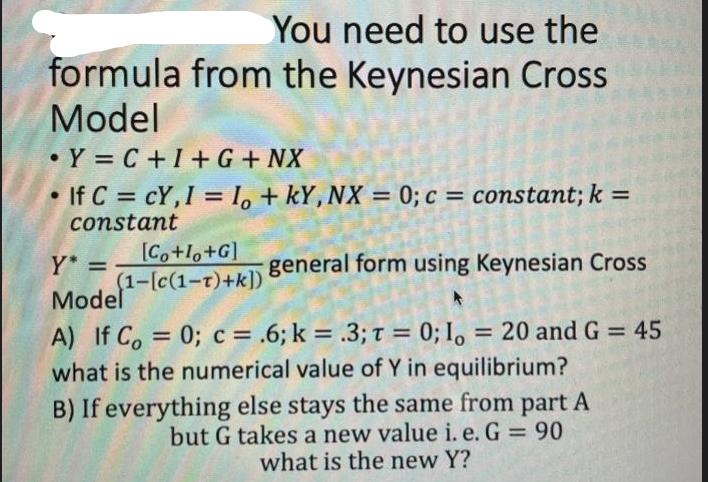Question
You need to use the formula from the Keynesian Cross Model Y=C+I+G+NX If C = cY,I = I + kY, NX = 0; c

You need to use the formula from the Keynesian Cross Model Y=C+I+G+NX If C = cY,I = I + kY, NX = 0; c = constant; k = constant Y* = Model [Co+lo+G] (1-[c(1-T)+k]) general form using Keynesian Cross A) If Co= 0; c = .6; k = .3; T = 0; 10 = 20 and G = 45 what is the numerical value of Y in equilibrium? B) If everything else stays the same from part A but G takes a new value i. e. G = 90 what is the new Y?
Step by Step Solution
There are 3 Steps involved in it
Step: 1
To find the numerical value of Y in equilibrium using the Keynesian Cross Model we ca...
Get Instant Access to Expert-Tailored Solutions
See step-by-step solutions with expert insights and AI powered tools for academic success
Step: 2

Step: 3

Ace Your Homework with AI
Get the answers you need in no time with our AI-driven, step-by-step assistance
Get StartedRecommended Textbook for
Fundamentals of Financial Accounting
Authors: Fred Phillips, Robert Libby, Patricia Libby
5th edition
78025915, 978-1259115400, 1259115402, 978-0078025914
Students also viewed these Finance questions
Question
Answered: 1 week ago
Question
Answered: 1 week ago
Question
Answered: 1 week ago
Question
Answered: 1 week ago
Question
Answered: 1 week ago
Question
Answered: 1 week ago
Question
Answered: 1 week ago
Question
Answered: 1 week ago
Question
Answered: 1 week ago
Question
Answered: 1 week ago
Question
Answered: 1 week ago
Question
Answered: 1 week ago
Question
Answered: 1 week ago
Question
Answered: 1 week ago
Question
Answered: 1 week ago
Question
Answered: 1 week ago
Question
Answered: 1 week ago
Question
Answered: 1 week ago
Question
Answered: 1 week ago
Question
Answered: 1 week ago
Question
Answered: 1 week ago
Question
Answered: 1 week ago
View Answer in SolutionInn App



